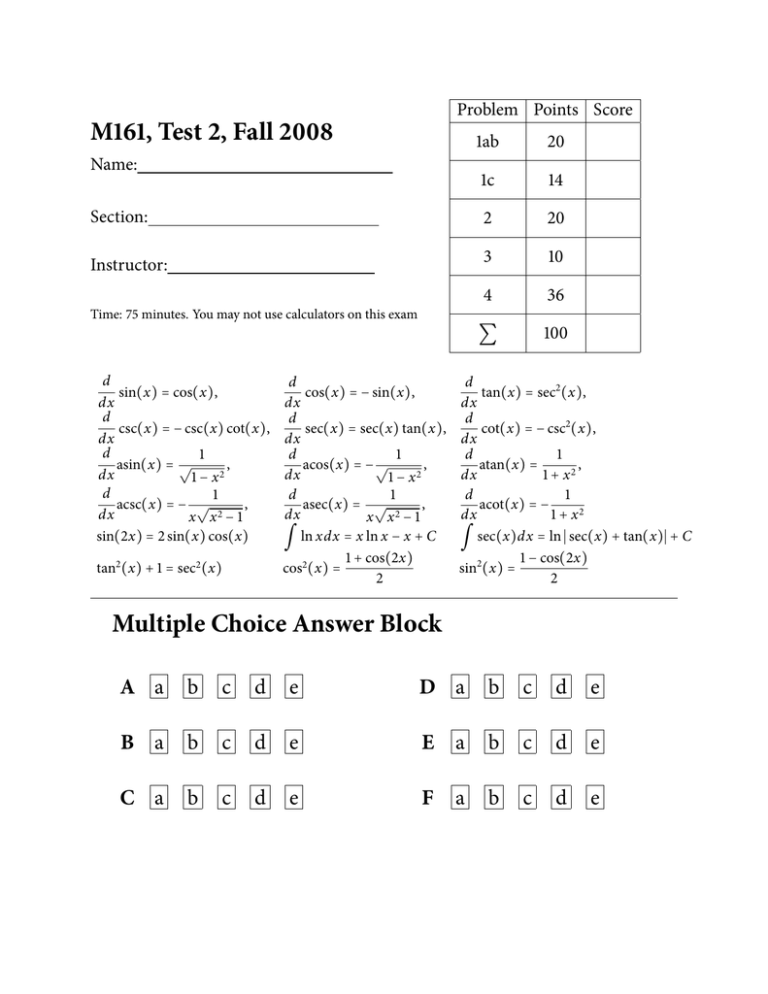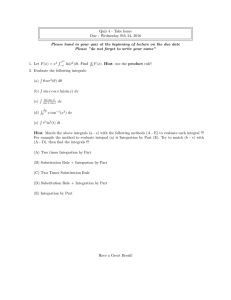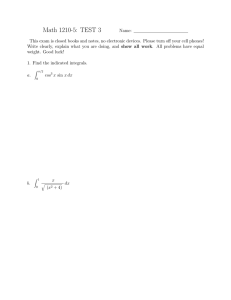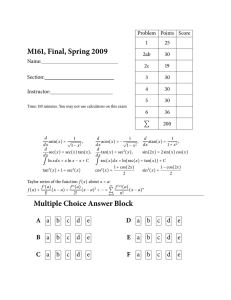M161, Test 2, Fall 2008 Problem Points Score 1ab 20
advertisement

Problem Points Score M161, Test 2, Fall 2008 1ab 20 1c 14 Section: 2 20 Instructor: 3 10 4 36 ∑ 100 Name: Time: 75 minutes. You may not use calculators on this exam d sin(x) = cos(x), dx d csc(x) = − csc(x) cot(x), dx d 1 asin(x) = √ , dx 1 − x2 d 1 acsc(x) = − √ , dx x x2 − 1 sin(2x) = 2 sin(x) cos(x) tan2 (x) + 1 = sec2 (x) d cos(x) = − sin(x), dx d sec(x) = sec(x) tan(x), dx d 1 acos(x) = − √ , dx 1 − x2 1 d asec(x) = √ , dx x x2 − 1 ln xdx = x ln x − x + C 1 + cos(2x) cos2 (x) = 2 ∫ d tan(x) = sec2 (x), dx d cot(x) = − csc2 (x), dx d 1 atan(x) = , dx 1 + x2 1 d acot(x) = − dx 1 + x2 sec(x)dx = ln ∣ sec(x) + tan(x)∣ + C 1 − cos(2x) sin2 (x) = 2 ∫ Multiple Choice Answer Block A a b c d e D a b c d e B a b c d e E a b c d e C a b c d e F a b c d e Evaluate the following integrals. Show your work. √ √ a) sin( x)dx (Hint: Start by substituting x). 1) b) ∫ 2 ∫ 1 − x dx 2 c) ∫ x2 dx, (x > 1) (x 2 − 1)5/2 2) For each of the following improper integrals determine, using a suitable comparison test, whether the integral converges or diverges. (You do not need to calculate the values of convergent integrals.) State clearly what comparison you are using, what function you compare with, and show that f < g, respectively work out the limit of f /g. No points will be given if no work is shown. ∞ ln(x) dx a) x 3/2 1 ∫ b) ∫ 1 ∞ 2x dx x4 Set up the partial fraction decomposition with constants A, B, C and so on for the rational x 3 + 2x + 7 . Note that the denominator is not fully factored. (You do not function (x + 5)3 (x 2 − 4)(x 2 + 2) need to solve for the constants or to find an antiderivative!) 3) 4) The following multiple choice problems will be graded correct answer only. You do not need to show work, and no partial credit will be given. Record your answer in the answer block on the front page. Answers given on these pages will not be scored. You also may tear off these pages and do not need to hand them in. It is strongly recommended that you work out the problems until the correct answer is uniquely determined and don’t just try to solve them by “intuition” or “guessing” – doing so is likely to result in a wrong pick. Each correct anwer is worth 6 points, each incorrect answer is counted as −2 points. (Unanswered questions are 0 points, questions in which more than one answer is ticked are considered to have been answered wronly.) You cannot get less than 0 points in this part. A) Integrating ∫ x arctan(x)dx by parts, we obtain an expression of the form A − ∫ Bdx. What is B? a B) a e 1 + x2 2x b 2x 1 + x2 c arctan(x)x 2 2 What are all the values p, for which d ∫ 1 ∞ x2 1 − x2 e 1 dx converges? x 2p p < −1 b p > 0 c p > 1 d p > 21 There are no values of p for which the integral converges. x2 2 + 2x 2 3n + 4 , which has limit L = 3. Determine the n 1 for any n > N smallest value of N, for which ∣a n − L∣ < 100 a 25 b 100 c 200 d 300 e 400 C) Consider the sequence a n = D) Solve a c e ∫ sin (x) cos (x)dx 3 cos5 (x) cos3 (x) − +C 5 3 cos4 (x) sin3 (x) − +C 4 3 − cos3 (x) sin2 (x) + C 2 b d cos4 (x) cos6 (x) − +C 4 6 cos3 (x) sin2 (x) + +C 3 2 Which of the following three integrals are convergent? E) A. ∫ ∞ 1 a b c d e B. ∫ 1 ∞ 3 dx x(x + 3) C. ∫ 1 ∞ 9 dx 5x + 2 Integrals A,B and C are convergent Integrals A and C are convergent, B is divergent Integrals B is convergent, A and C are divergent Integrals C is convergent, A and B are divergent Integrals B and C are convergent, A is divergent Suppose you apply the standard trigonometric substitution to evaluate F) ∫x x2 dx (x + 4)(x + 7) 4 √ 1 + x 2 dx. What integral do you get after making the trigonometric substitution? a c e ∫ sec (θ) tan(θ)dθ ∫ sin (θ) cos (θ)dθ ∫ tan (θ) sec (θ)dθ 4 4 2 4 3 b d ∫ sin(4θ) cos(2θ)dθ ∫ tan (θ) sec(θ)dθ 2




